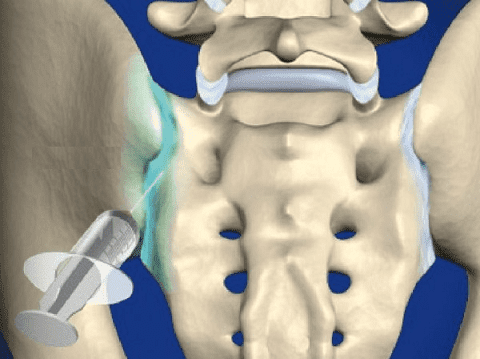Minimally Invasive Sacroiliac Joint Pain
The sacroiliac joint (SI joint) is the joint bridging the lowest segment of the spinal column (sacrum) to the bones of the pelvis (ilium). The integrity of the sacroiliac joint depends on strong ligaments that encase and cover the joint, both the front and back. These ligaments compress and stabilize the joint, keeping it together and limiting its’ motion. These joints support the upper body when we are standing.
The ligaments that encase the sacroiliac joint may stretch due to injury or may degenerate due to age, allowing the joint to have excessive motion. This excessive motion may inflame and disrupt the joint and stimulate the nerves causing pain. The pressure on the joint caused by excessive weight is also a potential cause of pain.
After a time, the SI joint can develop arthritis and become painful, particularly when walking and climbing stairs. Your physician may also refer to sacroiliac joint pain by other terms like sacroiliitis, SI joint degeneration, SI joint inflammation, SI joint syndrome, SI joint disruption, and SI joint strain/sprain.
Causes of sacroiliac joint disorders can be split into five categories:
• Traumatic (lifting, fall, accident)
• Biomechanical (leg length discrepancy, prior lumbar fusion)
• Hormonal (pregnancy/childbirth)
• Inflammatory joint disease (sacroiliitis) Associated with a generalized arthritic condition
• Degeneration (age-related wear and tear)
Symptoms
The most common symptom of sacroiliac joint disorders is pain in the lower back, buttock, and sometimes in the same side leg. This can present as sciatica-like symptoms (leg pain, burning, numbness, and tingling) that mimic lumbar disc or radicular low back pain, pain that radiates down into the legs. Most frequently it radiates to the buttock and thigh.
Diagnosing
 In order to diagnose the sacroiliac joint as the pain generator, your physician will typically start with a history and a physical examination. During the physical examination, your physician may try to determine if the sacroiliac joint is the cause of pain through movement of the joint. If this joint movement recreates the pain, the SI joint may be the cause of the pain.
In order to diagnose the sacroiliac joint as the pain generator, your physician will typically start with a history and a physical examination. During the physical examination, your physician may try to determine if the sacroiliac joint is the cause of pain through movement of the joint. If this joint movement recreates the pain, the SI joint may be the cause of the pain.
Your physician may also use X-rays, CT-scan or MRI to help diagnose the sacroiliac joint. It is also important to remember that more than one condition (like a disc problem) can co-exist with sacroiliac joint disorders. This means that even if the sacroiliac problem is addressed, pain may still be present in the area. Your doctor should discuss this with you.
Finally, your physician may request sacroiliac joint injections as a diagnostic test. Sacroiliac joint injections involve injecting a numbing medication into the sacroiliac joint. If the injection temporarily alleviates your symptoms, then your sacroiliac joint may be the likely source of your pain.
These injections are not done in the office but are done in a fluoroscopic suite. The response to the injection may last for hours, days, or weeks and depends on the disease process. What is looked for is a temporary resolution of your pain complaint that brought you to the doctor. This temporary resolution has to be dramatic at 70% pain relief or more.
Treatments
Treatment may involve physical therapy and repeated SI joint injections to manage the pain. For patients who are no longer responding to conservative care, an SI joint fusion may be suggested as a minimally invasive surgical option.
